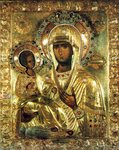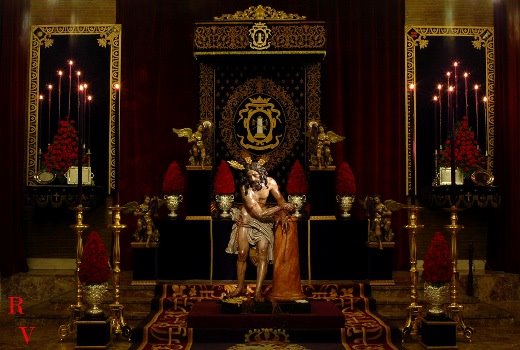
One of the most unusual stories I heard when I was in Ilocos Norte was the legend of how the town of Burgos got its name. In the past, say the old folk, it was called Nagparitan, an Ilocano word which means 'forbidden', more or less. The people aver that prior to the Spanish conquest, that town was the abode of fierce warriors, vengeful, proud, and terribly ruthless. Came the time when the Augustinians first sent missionaries to that proud northern province; it so happened that one priest chose Nagparitan to be his 'home base'. Initially discouraged by his superiors because of the unforgiving nature of the Nagparitanons, he nevertheless proceeded with his mission, and God be praised, the priest made headway among that proud warrior race.
As the priest's power and influence grew, some old shamans, servants of the elder gods of the Ilocanos, plotted against the priest. Eventually they convinced the village chiefs that the missionary was up to no good; and in the dead of night, they seized the priest from the convent, and proceeded to hack his body into several pieces, scattering the butchered parts in different areas as a warning not to tempt the power of the old gods. The town was now called 'Nagpartian', which meant 'butchered'. Almost immediately, evil things fell upon the land; the soil, it was said, turned red, and even now tales of lost spirits that haunt the wary traveler are common in that part of the country. For years the people of Nagpartian lived under the shadow of their evil deed, begging the God of the man they slew to save them from His wrath. Our guide said that many of them vowed to go barefoot for years if only the curse would be lifted. It was not until the town changed its name to Burgos, after the brilliant, martyred Filipino nationalist priest Fr. Jose Apolonio Burgos, did things pick up for the haunted town.
In many parts of the Philippines, tales such as the one above are still common, although admittedly not as popular as they were in older, more genteel times. The drama of good versus evil is played out in narrative in the most extravagant, most lurid traditions of the baroque, acquiring an almost gothic flavor. It was tales such as these that nourished the faith, wonder, and sense of community of my ancestors. The good, while initially crushed and defeated, is ultimately vindicated by an act of God, punishment raining down on the heads of the impious. It is very different from how the blogosphere, in general, seems to portray the Church.
Maybe it's a sign of the times, but I am watching Fox News more and more-- not becuase I believe the bs that they spew (admittedly some good points, but nothing one can't see from a distance) but because I am fascinated by the fact that many conservative, traditionally-minded Catholics seem to think that whatever it says must be the truth. Or more accurately, just because it appears on that network, automatically makes it more 'profitable' for one's suburban salvation. And this is not a phenomenon limited to Fox, it is the same animating principle behind armchair liturgical criticism (as if one were discussing a ballet! ugh!), covert racism masquerading as patriotism, and just about anything 'counter cultural.' In short, just because it is counter cultural, it follows that it must be correct.
You might be wondering: how exactly are the name changes of a quaint rural town in the northern Philippines related to American counter cultural gimmicks? There is the issue of sin to consider: in the former, the sin committed was the brutal murder of a servant of God. And the latter? The answer is none. It has done nothing at all, except being counter cultural. The former demonstrates how good men--and the good, in general-- are not so good after all. For the men of the tribe of ancient Nagparitan were considered to have been one of the most hardworking in the entire Philippines, who proudly defended their values and lifestyles from foreign influence. All of these are admirable traits, and strangely, these are the same things which one often hears from the talking heads at Fox. But I think this is precisely the problem: Good is not good enough. And it is certainly no equivalent to holiness.
While I am certainly not anti-American, I think some of the things which I post here do merit considerable cause for concern. In my opinion, Americans, as a people, are too 'good', that is, pleasant and warm, that they feel they have no need for holiness. A good American Catholic is one who knows what page of the Missal to turn to at any precise point of the Mass, one who joins Chesterton and Lewis reading societies in their spare time, who collects graduals for fun, who can cite the number of liturgical abuses 'in vogue' at the drop of a hat. Let's be realistic here. Most hardcore Trekkies are expected to have even a basic command of Klingon and can cite technical specifications on why their universe is superior to the 'Star Wars' universe. That makes them good fans, not holy people. There seems to be an excessive feeling of sufficiency among most American Catholics that it is no wonder the cult of the saints, novenas, rosaries, and penitential processions (and yes, Ireland has these too) are seen as mere cultural accretions, and consequently, liable to be picked and adopted at random as if they were mere objects fought over by over-educated aesthetes. In such a universe as this, it becomes almost impossible to weep over one's sins, since, hey, I know the difference between a cope and a chasuble, and you don't, so hah, I'm a better Catholic, nyah.
Triumphalism is a curse. The Church on earth is not called the Church Militant for nothing. When an army clashes with another army, there is nothing romantic about that. Blood is spilled, limbs are hacked, joints are stabbed, eyes are gouged, children are orphaned, wives are defiled, entrails are gutted, excrement is expelled, kingdoms burn, and the spirit is crushed. You can carry all the glittering banners you want, and shout Deus Vult! at all the infidels, but there is no denying that war will always claim its toll. We have forgotten, it seems, how to weep. We have forgotten what it is like to resign one's fate to God's hands, its profound fear and fervent hope. In short, I believe that we are locking ourselves, if not constructing, an entirely novel, extremely myopic Church, one made in our likeness, with no need for holiness, just 'the good.'
I think the problem is that it all seems too sophisticated, too smart and too suburban for your average Third World parishioner. In fact, take the word 'sophisticated' and look at the first seven letters; they spell 'SOPHIST'. Plato, of course, lambasted the sophists as flatterers, who will teach the children of the elite what they wanted themselves to be taught. While the comparison may admittedly be vague, one can never disregard it completely. Just a week ago, I saw a video comment on Youtube by a supposed "Catholic" who believed that black people are inferior to Caucasians, not just in terms of civilization, but ontologically as well. The most chilling part was when this commenter later on likened the poor, starving children of Africa to apes. These are dangerous times for the Church in America. And America, believe it or not, matters greatly in the Catholic world, since it is the single most influential and not to mention the wealthiest (and perhaps the most visible, what with the sex abuse scandal) sector of the Universal Church. What America sneezes, all of us under its radar will naturally be affected by it.
It is always a good thing when the Church manages to relay Her message throughout the world. Hers is a voice that is, thankfully, still sane, still motherly and still claiming to know better for us. But one must always be wary of the people who do get the message-- for even if they do hear it, there is a great chance that much, too, will be lost in translation. When one enters the Church with the full assurance and confidence that he is part of the Elect, that is a conversion. But what one really needs is a metanoia.
The Church, it seems, has forgotten how to weep; or more to be more precise, Her members no longer do so. We have forgotten the Church Suffering, and even the Church Militant, and are content to lock ourselves in our little, sanitized world where it seems that holiness is no longer a requirement for salvation, just a nice, little option. The most frightening thing which we are faced now is not the rampant secularization around us, but the secularization-- the ethical-moral redaction to the 'essential Christ'-- within the elements of the Church. We no longer need His help, only His blessings.

































